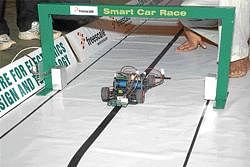

Staged in the country for the first time, the 'Smart Car Race India, 2010' saw the participation of nearly 290 students spread over more than 90 teams from 22 engineering institutes.
Organised by Freescale, the American manufacturer of semiconductors, in association with the Centre for Electronic Design and Technology (CEDT), and the Indian Institute of Science (IISc), the contest was aimed at fostering creativity and cultivating embedded design expertise among engineering students.
The competition required participants to assemble an intelligent model racing car, based on the microcontroller (MCU) technology, that can automatically recognise the specially designed racing track.
For this, a model kit, mentoring support, and necessary development tools were provided by Freescale. The teams, however, were not allowed to change or alter the model kits.
The team from Sardar Vallabbhai National Institute of Technology, Surat, the only participant from western India, clocked an average of 43 seconds for two laps and was declared the winner.
For Rikil Shah, Samir Sohi, and Maulik Gandhi, final-year B Tech (Electronics) students of the institute, it was an "out-of-the-world experience". They had to complete the two laps in just two attempts. Having failed to complete the second lap, they were a bit nervous.
A panel of experts from the automobile industry, the embedded systems domain and academia judged the participating teams on speed, design and technology.
On Monday, a preliminary round was held whereas a trial run of cars selected for the final round was held on Tuesday. While there were two identical racing tracks in the preliminary round, the finals had just one on the racing field. Time was calculated when a car left the starting line.
Asked how their automobile recognised the tracks, Gandhi said: "The optical infrared sensors installed in the front generate a higher voltage for white lines (on the track) and lesser voltage for black ones. Then we identify the error and a signal is given to the server to keep the car on the correct path. Before that, we converted the analog data into digital one." The team from Delhi Technological University walked away with the second prize of Rs 50,000, while PSG College of Technology, Coimbatore stood third and had to be content with Rs 25,000.
Teams from Aligarh Muslim University, Vellore Institute of Technology, and Thiagarajar College of Engineering, Madurai won consolation prizes of Rs 10,000 each. No team from Bangalore’s three institutes - IISc, RVCET, and PESIT - could win a prize.